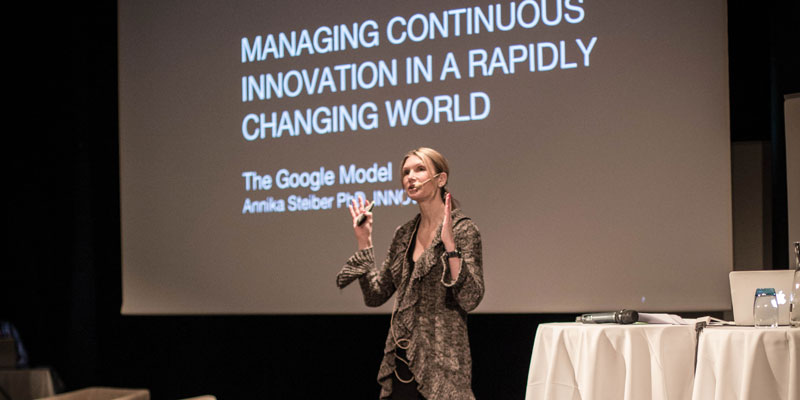
The Google Way to Increased Innovation – an Interview with Annika Steiber
Table of contents
Innovate or Die
In today’s fast-changing industries, companies face two alternatives – to innovate or die.
Obviously, the second alternative is not to prefer, and at the same time, realizing how hard it is to become the next “Google”, can be quite overwhelming.
So, what can you do to become more innovative and survive? Just copy and paste somebody else’s way of doing? According to Annika Steiber, that is not the right answer to the question. “You should always create your own model for innovation,” she states.
She is probably right. Still, understanding and learning from other leading companies and how they have succeeded in being innovative, can help you to develop a model of innovation that is just right for you.
6 key characteristics of a high innovation company
How the leading companies like Google have developed best practices in leadership, corporate culture, structure and processes, is based on a new set of management principles according to Annika Steiber.
These six management principles characterize successful companies in fast-changing industries.
“If we start with the most important one, which I think is the people-centric approach. These companies, they want entrepreneurs, they want really smart people, and they want to attract them and bring them in. They design the company, and the leadership after that kind of talents,” says Annika Steiber.
“Secondly, they are ambidextrous. They are able to do really efficient core business, they are industrialized, in parallel with driving successful new innovation to the market over and over again. That will require a parallel structure which is hard to create in reality,” Annika explains.
“Thirdly, these companies are not scared to disrupt themselves. They are dynamic in that sense that they are actively seeking what is going on, trends, and then bring those insights in, and reallocate their recourses. This is what I call dynamic capability,” Annika says.
“The fourth thing which is connected to the dynamic capability is openness. These companies are very well tapped into the innovation ecosystem, not only to local but also to international. They are well aware of companies which are excellent in their area and they try to collaborate with, invest in, or acquire these companies,” Annika explains.
The fifth management principle is related to the company culture. “They have a very strong culture of innovation. They embed innovation in everything they do, they live and breathe innovation, and something Annika calls a system approach to innovation. It is the engine, the key for their survival, and for their existence,” Annika says.
“The sixth principle is related to how agile their organization is. Their mentality is more or less to be prepared to change all the time. For some companies, this means that they work more project-oriented, e.g. work with strategically important things for the company in one project, and when that project is finished the employees might work with something completely different.
You are very open to that kind of changes all the time. So the people do what is important for the company, not what they are employed for at a fixed point in time,” Annika explains.
How do you start an innovation program?
Innovation work can be started on a smaller scale. “I recommend to start with some innovation pilots and actually learn how to do innovation work. Based on some pilots, check how the organization reacts and try to locate the problems in the organization that are hindering innovation. By doing that you will hopefully create success, buzz and lot of engagement around this.
To build an innovation capability is a learning process, you start small and scale over time,” Annika explains.
Investments in innovation work do not differ from any other business investments.
“It is like investing in a new product area or technology, you have to do it for many years, and you learn how to do it. This is the same thing, you will invest and learn how to manage innovation. It will take years to be very skillful in this,” she says.
Individuals who make a difference
The responsibility for innovation lies on different levels in the company. “Innovation is more or less always driven from the bottom up. It’s never from the top. What the top can do is to set some directions, some innovation domains.
For example, if the management says they want to go mobile and they do not know how, but they need to find innovations, it could be a new business model or just a new consumer interface. The individual is the key.
On the other hand, the management is also the key – in order to set the demand for innovation. So the individual is the supply, the source of innovation, the supply mechanism of innovation and top management would be the demand mechanism of innovation,” Annika explains.
People who can drive innovation are quite easy to spot.
“I have been working in companies in many years and I could easily say exactly which 10 persons made the difference. I think that any company can do that. I am actually quite shocked by how few companies have actively been identifying these persons, and actively supported them to create new cool things that could have an impact on new business and customers. Every company has a pool of entrepreneurial talent already and they could capitalize better on these persons.” says Annika.
“Another problem is that when they look at the CV of a true entrepreneur, the HR people cannot handle that kind of CV because it is too far from the traditional, standard CVs they are looking for. They perceive that it is a big risk for them to invest in these entrepreneurial people because they might not want to follow the traditional rules and routines of a larger company,” Annika states.
What is your top advice for TECHNIA customers?
“The advice would be to use TECHNIA as an important partner in their innovation process. Involve and integrate TECHNIA into their innovation process, and innovate together. TECHNIA will have insights that they do not have. And on the other hand, they have insight that TECHNIA does not have. And by doing a joint collaboration, you can come up with something really valuable for the customer,” Annika says.
Discover more about TECHNIA’s PLM solutions


